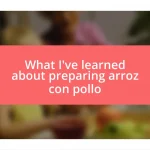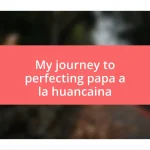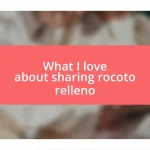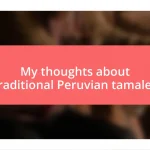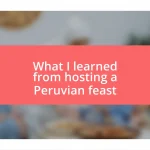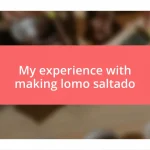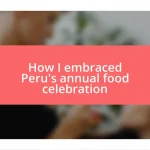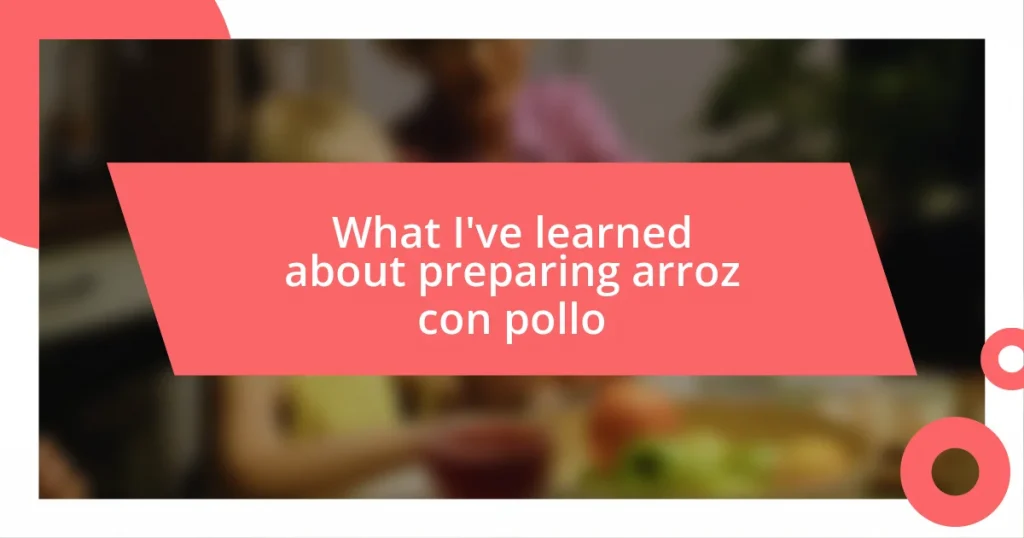Key takeaways:
- Peru’s food culture is deeply connected to its history and local traditions, with street markets and festivals serving as vital avenues for experiencing authentic cuisine.
- Signature dishes like ceviche, lomo saltado, and aji de gallina highlight the fusion of indigenous ingredients and culinary influences throughout Peru, showcasing the country’s rich agricultural heritage.
- Engaging with local communities enhances the culinary experience, providing insight into cultural significance and creating lasting connections through shared meals and stories.

Exploring Peru’s Food Culture
Peru’s food culture is a vibrant tapestry woven from its history, geography, and diverse traditions. I still remember the moment I first tasted ceviche by the sea in Lima, the flavors exploding in my mouth like a burst of sunshine. Have you ever experienced a food that instantly transports you to a different place? That’s exactly what authentic Peruvian cuisine does—it invites you to explore its rich heritage with each bite.
Street markets are another gateway into the heart of Peru’s culinary scene. I often found myself wandering through bustling stalls, caught between the enticing aroma of roasted meats and the vibrant colors of local fruits. There’s a certain magic in a market; it’s not just about food. It’s about the stories behind each dish, the laughter shared over a steaming bowl of causa, and the connections formed with local vendors. How can food stories resonate so deeply? They connect us, reminding us of our own lives and traditions while inviting us to relish the unique flavors of Peru.
Traditional festivals also play a monumental role in showcasing Peru’s culinary heritage. I’ll never forget experiencing the Inti Raymi festival in Cusco, where the celebration was infused with the spirit of the Incan ancestors, and every dish offered was a homage to their agricultural bounty. Isn’t it remarkable how food can transcend time and culture? Witnessing these traditions firsthand not only broadened my palate but also deepened my appreciation for the cultural significance of each festival feast.

Understanding Peru’s Culinary Heritage
Understanding Peru’s Culinary Heritage
There’s a unique charm in how Peru’s diverse culinary heritage reflects the country’s multifaceted identity. I still recall the first time I learned about the fusion of indigenous ingredients and Spanish techniques. It was during a cooking class in a cozy kitchen in Cusco, where I felt an overwhelming sense of connection to the land as I prepared a traditional dish called pachamanca, which involves cooking meat and potatoes in an underground oven. This experience made me realize how food is not just sustenance; it’s a narrative of cultural exchange.
Exploring the vast range of flavors in Peru often leads me back to the importance of traditional ingredients. For instance, the use of native potatoes—over 3,000 varieties!—is central to many dishes. I remember tasting a beautiful purple potato puree that brought back memories of vibrant marketplaces filled with these delightful colors. Who knew that each variety tells a story about the region it comes from, reflecting the local soil and climate? This deep-rooted connection to ingredients is what sets Peruvian cuisine apart; it’s a living testament to its agricultural heritage.
Moreover, the communal aspect of dining in Peru captivates me every time. I had a profound experience during a family dinner where everyone came together to share a feast of anticuchos and tasty tamales. It reminded me of how food acts as a fabric that binds families and communities. It’s in these gatherings that one truly understands why culinary practices have been preserved through generations—each dish serves as a bridge among family, history, and culture, celebrating togetherness.
| Culinary Aspect | Details |
|---|---|
| Ingredients | Indigenous staples like quinoa and potatoes blend with foreign elements. |
| Cooking Techniques | Peruvian dishes often showcase unique methods such as pachamanca. |
| Social Importance | Food serves as a connection between family and community traditions. |
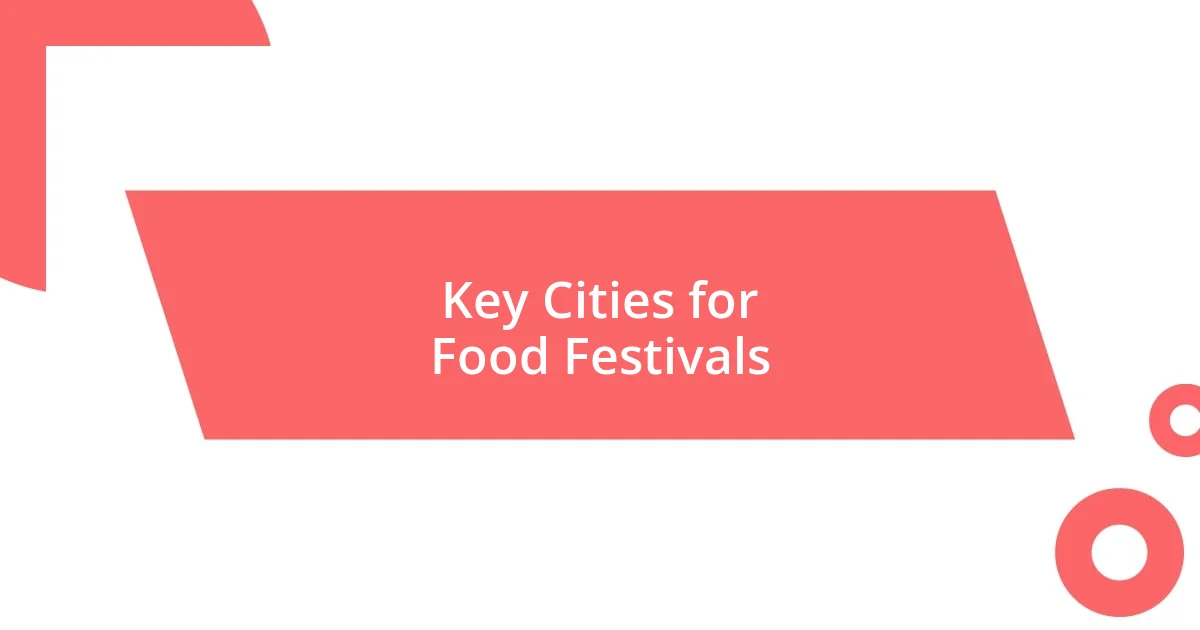
Key Cities for Food Festivals
The vibrant cities of Peru each bring their unique flair to the food festival scene, making them essential stops for anyone looking to indulge in authentic culinary experiences. Lima, for instance, is home to the famed Mistura, where countless food vendors showcase their signature dishes, from classic ceviche to innovative street food. I remember standing in line, chatting with locals while savoring a heavenly dish of lomo saltado; it was exhilarating to be surrounded by so much passion for food.
Another city that stands out is Cusco, where the Inti Raymi Festival not only celebrates the winter solstice but also features a feast that highlights local ingredients and traditions. During my visit, I felt proud to join the locals during this festive occasion, sharing dishes that represented both the past and present of Peruvian cuisine. These interactions left a lasting impression on me, reminding me how food festivals are not just about eating; they’re about community and heritage.
Here are some key cities known for their vibrant food festivals:
– Lima: Hosts Mistura, a celebration of Peruvian gastronomy.
– Cusco: Features Inti Raymi, showcasing traditional Andean dishes.
– Arequipa: Known for the Arequipa Festival, spotlighting local culinary treasures.
– Trujillo: Celebrates the Marinera Festival with gastronomic delights.
– Iquitos: Hosts the Amazon Festival, focusing on unique jungle ingredients.

Signature Dishes to Try
When it comes to signature dishes, there are a few that simply cannot be missed. One dish that stole my heart is Ceviche, a bright and refreshing mix of fresh fish cured in lime juice, typically accompanied by red onions, cilantro, and a touch of chili. The first time I tasted ceviche at a beachfront market in Lima, I felt an instant connection to Peru’s coastal culture. The balance of acidity and freshness was like a culinary revelation—why don’t we have more flavors like this in the world?
Another exquisite dish on my list is Lomo Saltado, a delightful stir-fry that marries tender beef strips with onions, tomatoes, and a splash of soy sauce, all served over a bed of fluffy rice and fries. This fusion dish reflects the melding of Chinese and Peruvian influences. I fondly recall a small family-owned restaurant where the warmth of the owners matched the comfort of the meal. As I savored each bite, I couldn’t help but marvel at how food can blend different cultural backgrounds into something truly harmonious.
Lastly, let’s not forget the heavenly* Aji de Gallina*. This creamy chicken dish, made with aji amarillo peppers, walnuts, and bread, showcases the rich flavors of Peruvian cuisine. The first time I spooned it onto my plate, the luscious texture and comforting aroma embraced me. It left me wondering—how can food evoke such memories and emotions? This dish truly exemplifies how each bite is a labor of love, telling stories of home and tradition.

Planning Your Food Festival Itinerary
When planning your food festival itinerary in Peru, timing is crucial. I learned this the hard way when I mistakenly arrived in Lima a week late for Mistura. Can you imagine my disappointment? That festival is one of the highlights of the Peruvian culinary calendar, so I can’t stress enough the importance of checking the festival dates well in advance. Make sure to align your travel schedule with the festival dates to fully immerse yourself in the experience.
As you create your itinerary, consider the regional specialties you want to explore. Each city has its own unique flavors, and I found that focusing on local dishes offered a more authentic experience. For instance, while in Arequipa, I took a culinary class that introduced me to the traditional use of rocoto peppers. I had a blast learning to prepare my own spicy rocoto relleno, a dish I still crave to this day. Which local ingredient are you most excited to discover?
Lastly, don’t forget to leave some flexibility in your plans. I remember wandering through the streets of Cusco during the Inti Raymi Festival, and I stumbled upon a hidden food fair that wasn’t on my radar. Being spontaneous led me to try a mouthwatering causa that I still dream about. Sometimes, the best experiences are those you didn’t plan for, so be ready to let the culinary adventure unfold!
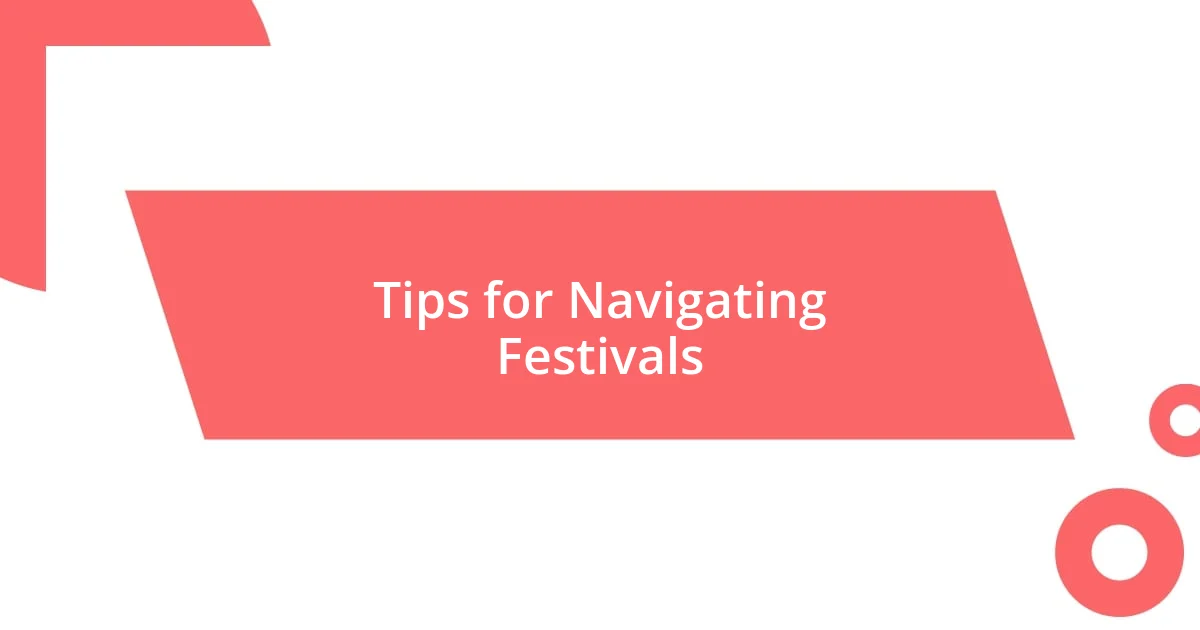
Tips for Navigating Festivals
When you step into a festival, preparing to wander is key. I’ve learned that some of the best discoveries happen when you stray from the main events. For example, at a small festival in the Sacred Valley, I followed the music and ended up tasting an incredible homemade tamale from a local vendor who shared stories of her grandmother’s traditional recipes. Have you ever found a hidden gem just by following your curiosity?
Navigating crowds can be intimidating, especially when you’re eager to savor every bite. I find that arriving early grants me the luxury of experiencing everything without the rush. During Fiesta de la Vendimia in Ica, I strolled through the market before the throngs of visitors arrived. This not only let me chat with vendors but also gave me first dibs on freshly made empanadas. Isn’t it freeing to savor your food at your own pace?
Finally, don’t underestimate the power of chatting with locals. Engaging in conversations can lead to discovering off-the-beaten-path experiences. At the Feria Gastronómica in Lima, a friendly chef shared a secret spot for the best anticuchos, and let me tell you, the flavors were out of this world! Isn’t it fascinating how just one recommendation can lead you to new culinary heights?
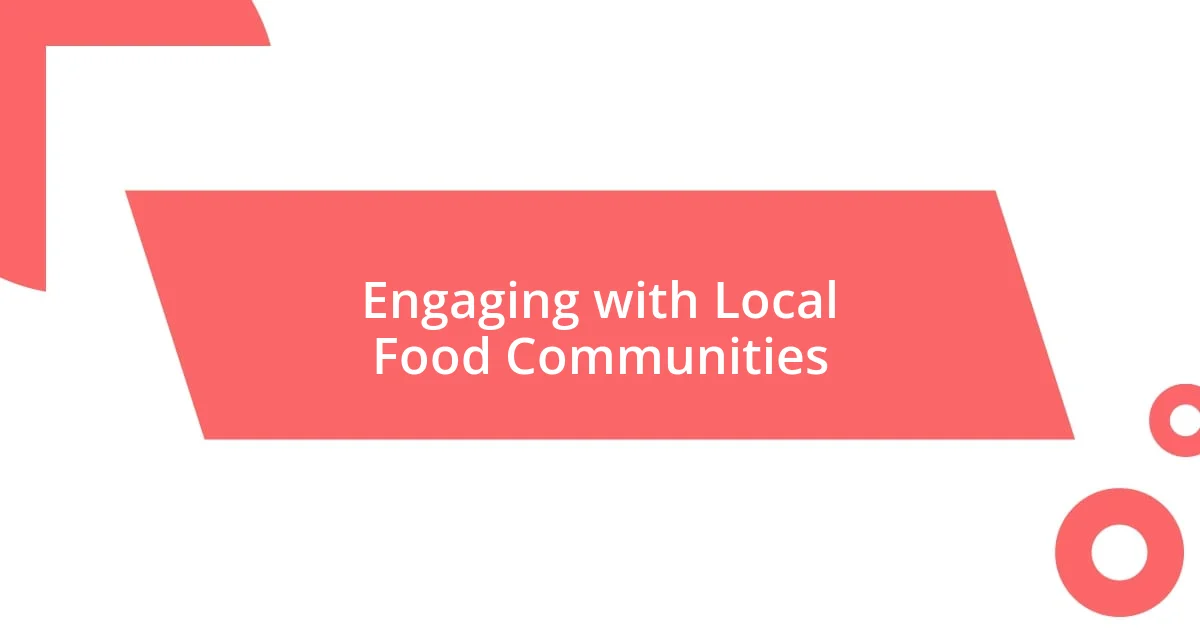
Engaging with Local Food Communities
Engaging with local food communities has been one of the most rewarding aspects of my culinary adventures in Peru. During a quiet afternoon in Trujillo, I stumbled upon a vibrant community market bustling with locals. As I joined the crowd, the aroma of fresh ceviche wafted through the air, drawing me to a small stall where the vendor eagerly invited me to taste his family’s secret recipe. Why do you think these local connections always seem to yield the richest flavors?
I vividly recall forming friendships with local cooks and vendors. One evening, while enjoying a festival in Puno, I met a charming family who invited me to their home for a traditional feast. Sharing that meal, with laughter and stories swirling around the table, was far more than just a taste experience—it was a glimpse into their lives and culture. How often do we get to connect with the soul of a community through food?
Embracing the local food culture requires a willingness to participate. I remember joining a community cook-off in a small village, where everyone brought their favorite dish. Not only did I learn to make a delicious lomo saltado, but I also gained insights into the significance of each ingredient reflecting their heritage. Have you ever felt that sense of community when cooking together? It’s those moments that truly enrich our understanding of and appreciation for the culinary world.
